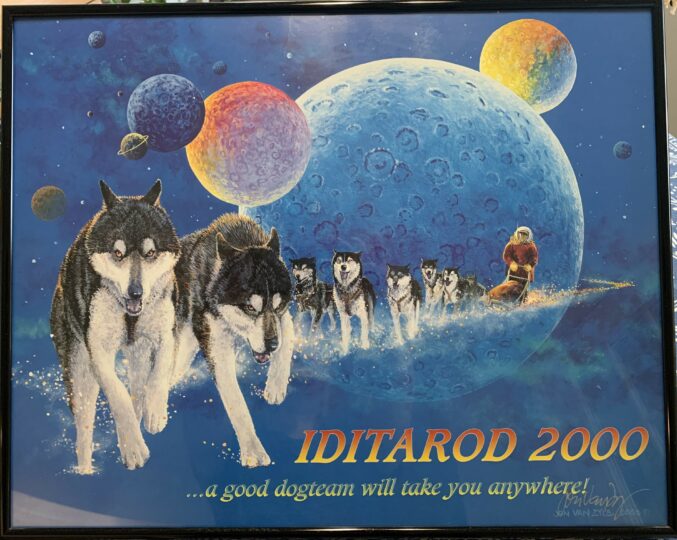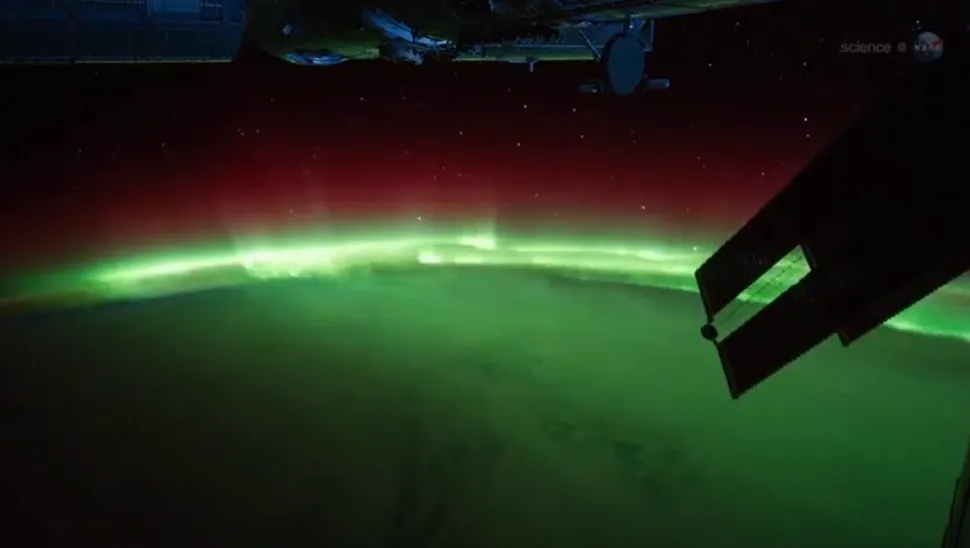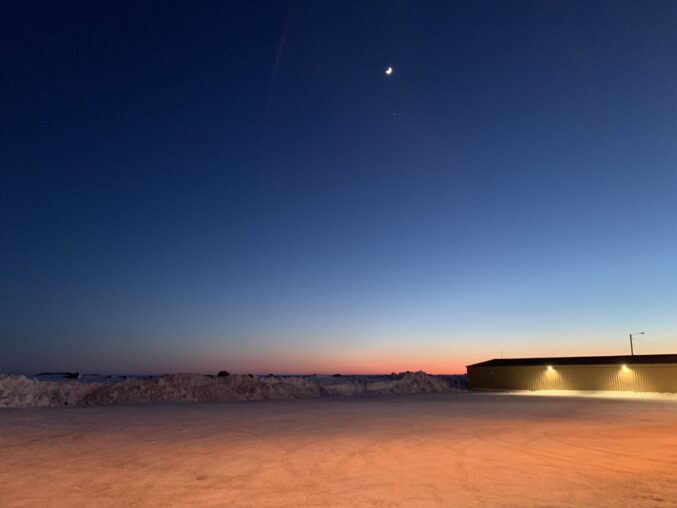The second question people ask me about my time on the Iditarod Trail, after “did you survive the cold?” is usually, “Did you see northern lights?” My answer is, yes, sort of. On the second night in Galena, a checkpoint along the Yukon river, a faint swirl of northern lights appeared in the sky. It hovered over the resting area for the dog teams as local people and trail volunteers gathered to observe it. We stood together in the very frosty night air watching this celestial treat.

Aurora Borealis lighting up the sky above Tanana. Photo Credit: Terrie Hanke
One of the great rewards of being in Alaska, or in space, is having the unique perspective to observe celestial phenomena. Not just northern lights, but starlight, the movement of the moon and sun, and other planets. Both places offer a view that is free from light pollution. Both places offer humans a way to connect with nature beyond the earth. And as it turns out, I’m far from the first person to share connections between the Iditarod and space. A week or so after I returned home from Alaska, Terrie Hanke, author of Eye on the Trail and 2006 Teacher on the Trail, messaged me to watch my mail for a box. Inside the box was this beautiful race poster from 2000 created by Jon van Zyle, official Iditarod artist. Wow! A wonderful gift!

2000 Iditarod race poster featuring a space-themed image by Jon van Zyle.
I love this image for so many reasons. It combines two of my favorite things—sled dogs and space. It depicts the Iditarod trail as a pathway through the heavens. Planetary orbs hover above the dog team—not in scientific ratios but as a suggestion that the Iditarod Trail is a special place away from reality, a far-off fantasy universe. I especially love the tag line of the poster: “A good dogteam can take you anywhere.” This sentence contributes to our sense of wonder about dog teams traversing the loneliness of remote Alaska, or silent spacecraft traveling through the vastness of space.
As astronauts orbit the Earth from the International Space Station, they often see beautiful displays of northern lights from above. It may seem strange to think of looking down on the aurora borealis instead of craning our necks like we usually do. But astronauts have a unique perspective on the auroras—and every once in a while an astronaut might even get to fly right through them. In an article from Space.com, astronaut Don Pettit (Expedition 30) says, “We can actually fly into the auroras. It’s like being shrunk down and put inside of a neon sign.”

The aurora borealis from the International Space Station. Photo: Don Pettit
Dave Poyzer, one of the Iditarod’s official photographers, has captured many images of the northern lights in his time on the trail. In this post from 2022, he describes the process of capturing both northern lights and three different dog teams, which he later compiled into a double exposure photograph. The night when the photographs were taken was bitterly cold, though “not without beauty,” says Dave.
Other readily observable celestial orbs are of course, the sun and moon. During my time on the trail, sunrises and sunsets were stunning and memorable. Friends also wanted to know, how much light did you get from the sun each day? This question refers to the tilt of the Earth’s axis as it rotates around the sun, and how much sun shines on a given part of the earth at certain times of the year. Sunsets were long and slow, and usually finished around 9:30 in the evening. The glowing evening light reminded me that even though the sun rose and set with certainty, mushers were not following a day/night schedule at all. I got to experience the moonlit trees in the Yentna checkpoint on the Jr. Iditarod, and the spectacular sunsets on the Bering Sea.

My silhouette in front of the earth’s curve and faraway sun in Unalakleet. Photo: Lena Haug
For millennia, humans have been gazing at the sky and observing with wonder the movement of stars, planets, and other bodies. It’s amazing to think that dog mushers from the mists of time were also observing the sunset, auroras, and moon phases just as Iditarod mushers and astronauts do today. Teachers often joke wryly about the full moon as a harbinger of student behavior expressions. I invite you to consider how observing phenomena in the skies enhances our experience of the Iditarod.

Crescent moon in Nome. Photo: K. Newmyer
How do you make connections between the heavens and Iditarod? Email me at emailtheteacher@iditarod.com.


